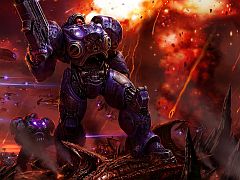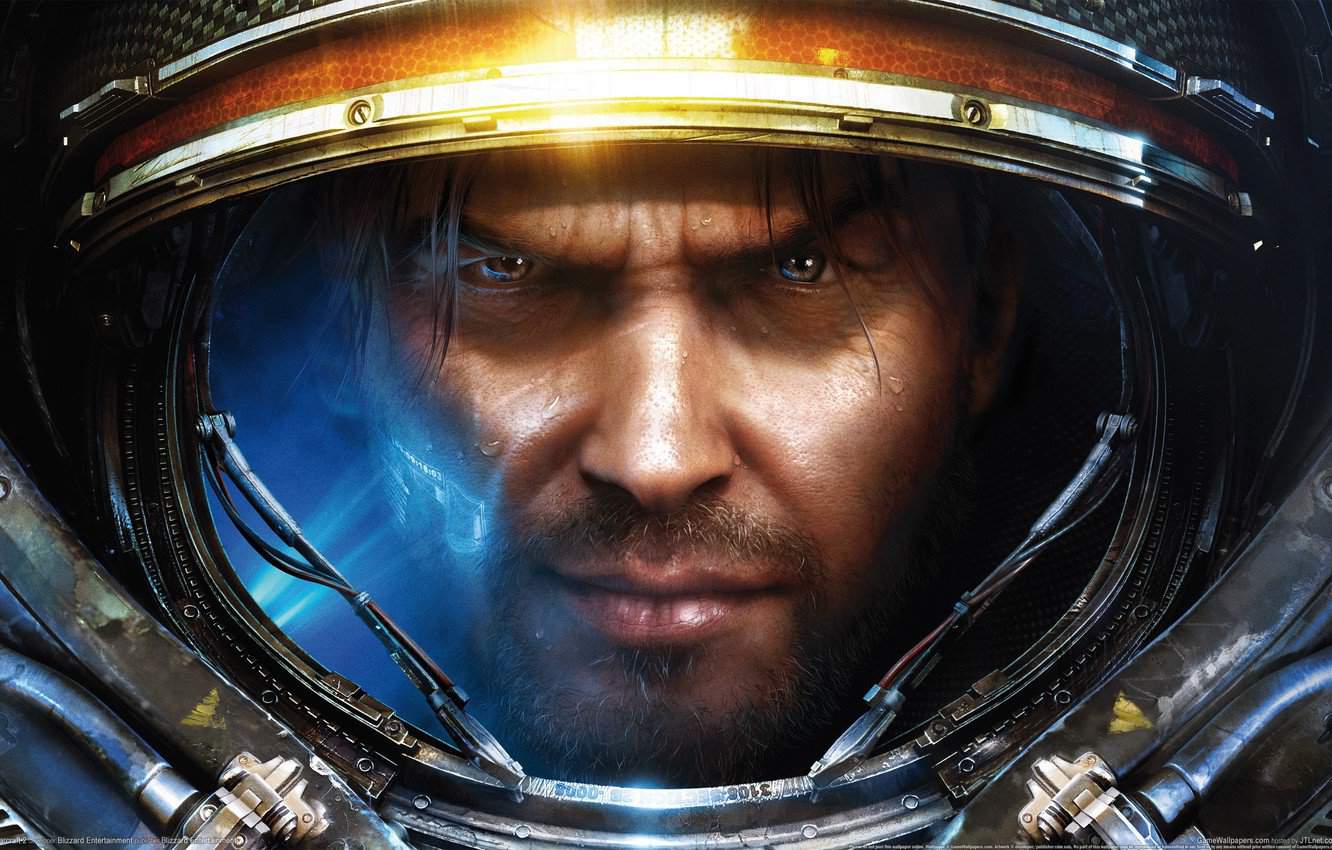You can trust VideoGamer. Our team of gaming experts spend hours testing and reviewing the latest games, to ensure you're reading the most comprehensive guide possible. Rest assured, all imagery and advice is unique and original. Check out how we test and review games here
When we left off, in 1998, the insectoid Zerg had just betrayed the technologically-advanced Protoss and Terran armies, wiping out all life on planet Char. The Protoss homeworld of Aiur had been thoroughly ravaged, an infant Overmind had been destroyed, and renegade Terran hero Jim Raynor was fleeing the might of the oppressive Dominion forces led by backstabbing sod Arcturus Mengsk. Also, I was 11.
These days, Jim Raynor is a broken man. His waking hours are spent sitting alone in bars, knocking back bottles of whiskey and listening to a cover version of Free Bird. At night his dreams are haunted by the Zerg rushing his one-time love Sarah Kerrigan, back when she was still human and not an oddly attractive Zerg Queen – one that resembles a cross between Tricia Helfer (who now provides the voice) and the work of H. R. Giger. Also, I am 24 in a month.
The more things change, the more they stay the same. The StarCraft of 2010 is not the StarCraft of 1998, but it does such a good job of respecting its source material you might end up thinking you’re basically playing the same game. You’d be wrong.
Crucially, there’s an all-important divide between the single and multiplayer components. The former’s campaign, the heart of StarCraft’s burgeoning space opera, has you controlling Raynor’s renegade forces on the Hyperion, his personal Battlecruiser. Keeping the narrative grounded to Raynor’s perspective, with the majority of levels based around the Terran race, gives Blizzard’s designers the chance to breathe, to let the game unfold at a more comfortable pace and create levels that bring out the best from each unit. New toys are introduced into the game on a one-by-one basis; each mission encourages you to your latest prize to accomplish the demands of each particular scenario.
Levels are glued together by impressive in-engine cutscenes, the occasional lavish FMV sequence and plenty of pottering about on your ship to spend money and research points – we’ll talk about the latter in a moment. The Hyperion is far more than just a giant spaceship with a massive pew-pew laser: it has its own laboratory, armoury, bridge and cantina, with each RPG-lite area presented as a moving image rather than as an interactive environment. The effect ends up feeling like a screen from a 90s adventure game, only with fancier technology.
A renewed focus on plot, atmosphere and setting is complimented by the fundamental mechanics of the game. Blizzard’s often-criticised decision to focus on the Terrans actually pays dividends when it comes to tailoring a squad over the 16-odd hour duration of the main campaign. Giving 29 lengthy missions to one race grants the supporting cast time to develop, resulting in a cohesive narrative that turns the experience into far more than a disconnected series of missions linked together by a loose plot. The ending’s not bad, either.
The last 12 years has seen the original StarCraft lifted to untouchable status in the gaming canon – and deservedly so. Cast the nostalgia to one side, however, and you’ll realise the story, especially some of the stuff introduced in the Brood War expansion, was a bit silly: fluff, filler and intentionally vague topics about Protoss/Zerg clones, an Earth faction and a Xel’Naga disguising himself as a Terran. StarCraft II has its own daft moments, but it’s a tighter, more controlled storyline that distils and expands upon the core elements that proved a success in the original: Raynor, Kerrigan and Mengsk.
There’s also a fair amount of technical improvement. The visual boost is obvious – though the game is gorgeous because of the art direction rather than raw engine power – but there’s also a vastly improved AI that no longer struggles with vitally important things like basic pathfinding. Thankfully the 12-unit selection limit is also gone, which makes squad micromanagement substantially easier. StarCraft is hard enough as it is, after all.
The campaign is full of neat tricks, and it never repeats them. One level has you racing against a mercenary captain to harvest minerals; another has you blowing up targets before a powerful enemy character gets to them. Elsewhere there’s one where you’re providing fire support to an NPC while he runs around, guns blazing, and takes sips from his hipflask. There’s even a bit where Blizzard takes cues from the 2D platformer genre, having you zoom from left to right to avoid an unstoppable wall of fire. The basics – building a base, some bunkers, a few marines and a couple of medics – are always in place, but Blizzard insists on throwing a unique element into each stage to both keep you on your toes and stop the hefty campaign from descending into tedious cycles.
StarCraft II’s stages sprawl across the galaxy, taking you through a variety of planets and palettes: across ornate temples, dingy caverns, charred and ashen wastelands and factories with spinning conveyor belts and red-hot smelting pools. These worlds boast intricate design and an abundance of incidental details, each with a unique aesthetic stamp, with textures and models rarely carrying over from one level to the next.
You won’t see all of them in a single run of the campaign, though, as StarCraft II occasionally commits to branching paths and forces you to ally yourself with a particular character (and their subsequent level) at the expense of another. These choices are few and far between, and while each one is quite exciting they mostly have negligible impact on the campaign’s direction. You might find yourself being forced to choose between the ability to manufacture Spectre or Ghost units, for instance, but at the end of the day it’s like comparing two varieties of apple instead of something more significant, like oranges and pears.
Unit and base upgrades are far more significant. Money is awarded for completing missions and goes on buffing the stats of your units, each of which get two potential upgrades – Siege Tanks the option to do 75 per cent less damage to friendly units, for example. Research points, gained from accomplishing bonus objectives in levels, come in two varieties, Protoss and Zerg, and you can choose one of two upgrades every time you accrue five points in each. By the time the end credits scroll you might have the ability to call down supply depots and units from space, manufacture pop-up flame towers and even control the minds of Zerg units. You’ll also be able to construct Vultures, Wraiths, Firebats and Goliaths – powerful returning units from the original that don’t show up in multiplayer.
The campaign is deftly executed, and Blizzard has successfully managed to shoehorn an overarching narrative and solid characters into a genre naturally opposed to such nuance. A sharp mind is required to clear the campaign, but lightning-fast micromanagement skills are not: StarCraft II manages to remain a challenging game without falling into that trap, which made the closing levels of the original more annoying than gratifying.
One potential problem is that the single-player campaign, with all its buffs, upgrades and exclusive units, makes an incredibly poor way to introduce you to the multiplayer part of the game. However, Blizzard nips this issue in the bud with a series of challenge missions: nine detailed, lavish arenas with limited units, pre-selected groups of enemies and a rigorous marking criteria, with a countdown timer and flashing on-screen commands segueing you from one demanding skirmish to the next. Each arena revolves around a certain theme – perfecting your build order, learning how to counter certain units – that should lend a helping hand, or at least provide a bit of practice, for the kind of tricks you’ll need to last longer than five minutes in competitive multiplayer.
And crikey, taking the game for a spin online can be a bit of an uphill struggle. Multiplayer is a fast affair, epitomising the virtues of the rush and solid micromanagement. Playing the game can have a severe effect on your brain, and a couple of hours spent in multiplayer can be a genuinely exhausting process. There’s a lot to do, and even more to observe, and you’ll need to learn your hotkeys and invest a large amount of your time into practicing the basics to scrape even a single victory, but the satisfaction derived from winning is immense – an intense rush of accomplishment and satisfaction that puts almost all other online games to shame.
Blizzard try and extend the olive branch to beginners by way of an unranked practice league and an effective system of bucketing players into skill-based ladders, but the level of competition is high and these tools will only benefit players who’ve already decided to commit to learning the intricacies of the game. It’s not an easy ride.
As expected, the new units have shaken up the dynamic of the three races from the original. Fans of quick rush tactics have taken an initial fancy to the Terran Reapers, for instance, who can jump up cliffs and cause endless problems by harassing the opponent’s harvesting units, and a well-executed MMM (marines, marauders and medivac dropships) strategy can cause endless problems to the Protoss or a Zerg opponent focusing on a Roach rush. I’m primarily a Terran player, but new and established strategies are equally prevalent for the other two races.
It’s here, in multiplayer, that you realise the sheer amount of strategic finery the game exhibits. Other RTS games have been able to have a jolly good crack at strong single-player campaigns – notably Relic’s efforts with Homeworld, Company of Heroes and Dawn of War – but no other developer has been able to devote the time and resources to creating and balancing such a strong multiplayer experience. Even WarCraft III, Blizzard’s last RTS, didn’t come close.
The decision to region lock the servers might cause problems if any Europeans fancy playing with North Americans (in tournaments, for instance) or vice versa, requiring players to import copies of the game and setup multiple profiles to access inter-continental play. It’s one of the controversial decisions Blizzard has taken with their revamped Battle.Net service, the most notable of which being how the game uses your real name to identify you online. While the system is certainly efficient and technically impressive, such demands can be a little off-putting. It shouldn’t detract anybody from the quality of the game, however.
Both the single and multiplayer parts of StarCraft II have legs, and each stand strong on their own: combine them in one package and you’re getting an awful lot of game for your money. StarCraft II can be daunting, distressing and demanding but it’s one of the richest and most expertly produced video games of recent years. StarCraft II is a shot in the arm for the RTS genre, filling a void that’s been left dormant for far too long – about 12 years, actually. StarCraft is dead. Long live StarCraft.

/https://oimg.videogamer.com/images/07b0/starcraft_2_128.jpg)






